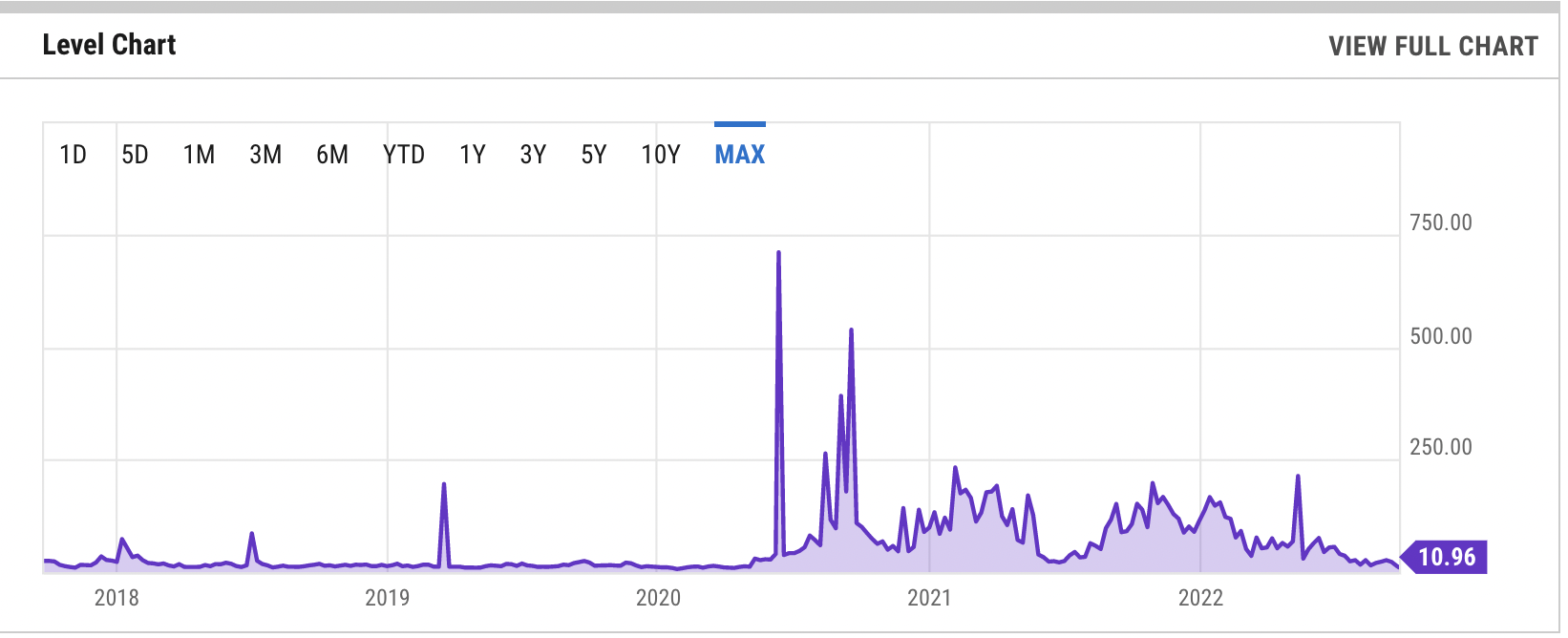The Ethereum network’s transaction prices (known as gas fees) have declined significantly since 2021, according to The Block.
The report stated that the Ethereum network was at its peak during the DeFi summer and boom in the non-fungible token (NFT) issuances in 2021.
The blockchain platform’s gas fees have fallen to the lowest point in the past years, as of Sept 22, data from The Block showed.
Ethereum’s average gas price for Sept 25, was 10.96 Gwei, according to Ycharts.com, and the highest was at 474.57 Gwei on May 1, 2022, down from 50.96 one year ago. This is a change of 20.73% from yesterday and -78.50% from one year ago.
The all-time high (ATH) of average gas fees even reached 709.71 Gwei, as of June 11 in 2020, which was much higher than the current level.

Source: Ycharts.com
Despite the fall in gas fees, Ethereum transaction count and daily active users have not dropped concurrently. According to The Block, the likely culprit could be that transacting users don’t see the need to pay high costs to complete their transactions quickly.
The Block Research data analyst Simon Cousaert explained that “people are not in a hurry and are not willing to pay more for their transactions to go through sooner.”
The report also added that statistics do not indicate nearing all-time lows, as shown by the total transaction count and active addresses on the Ethereum network. The opposite is the actual case; both have increased roughly 20% and 60% in the same two-year time frame, respectively.
Uniswap, OpenSea, and ETH transfers were the highest gas-consuming smart contracts in the past month, according to The Block’s data.
NFT marketplace OpenSea has been a huge contributor to a huge portion of the total gas consumption during the entire 14-month period but has fallen significantly since January.
The Block added that this caused other transactions on the network, such as transfers and token swaps, to cost an astronomical amount more.
There has been significant growth in the Layer 2 space. The report added that the primary growth was seen in optimistic rollup solutions such as Arbitrum and Optimism.
Transaction counts on the leading optimistic rollup solutions are on an upward trajectory, even though transaction costs are reaching new lows.
In another development, the latest upgrade on Ethereum (the Merge) is lowering the supply of Ether (ETH) in the proof-of-stake (PoS) consensus, data from Ethereum tracker Ultrasound Money showed.
The second larger cryptocurrency, however, may still have a long way to go before becoming deflationary.
Some of the key promises that the upgrade pledged to do for the Ethereum blockchain were to improve efficiency and make the network more scalable, lower the supply of Ether, thus making it a deflationary asset, and others.
Metrics from the web portal Ultrasound Money show that the supply of Ether under the proof-of-stake network has increased by more than 5,990 from the Merge event till now. But this number is lower than it could have been under the proof-of-work consensus mechanism, the data shows.
Besides that, the number is much lower than the supply of Bitcoin, whose network produces 6.25 BTC coins every ten minutes running on the proof-of-work mechanism.
According to the Ultrasound Money platform, Ether can become deflationary when the coins from block subsidy are lower than the ones being burned. Furthermore, ETH will become a deflationary asset when the number of people who transact with the coin grows higher than those who stake it.
Image source: Shutterstock
Credit: Source link






















 Bitcoin
Bitcoin  Ethereum
Ethereum  Tether
Tether  Solana
Solana  USDC
USDC  Lido Staked Ether
Lido Staked Ether  XRP
XRP  Toncoin
Toncoin  Dogecoin
Dogecoin  Cardano
Cardano  Shiba Inu
Shiba Inu  Avalanche
Avalanche  Wrapped Bitcoin
Wrapped Bitcoin  TRON
TRON  Bitcoin Cash
Bitcoin Cash  Polkadot
Polkadot  Chainlink
Chainlink  Polygon
Polygon  Litecoin
Litecoin  NEAR Protocol
NEAR Protocol  Internet Computer
Internet Computer  LEO Token
LEO Token  Uniswap
Uniswap  Dai
Dai  Aptos
Aptos  Ethereum Classic
Ethereum Classic  Mantle
Mantle  First Digital USD
First Digital USD  Stacks
Stacks  OKB
OKB  Cronos
Cronos  Filecoin
Filecoin  Cosmos Hub
Cosmos Hub  Stellar
Stellar  Bittensor
Bittensor  Arbitrum
Arbitrum  Render
Render  Hedera
Hedera  Maker
Maker  Immutable
Immutable  dogwifhat
dogwifhat  Injective
Injective  Ethena USDe
Ethena USDe  The Graph
The Graph  Optimism
Optimism  Wrapped eETH
Wrapped eETH  Fetch.ai
Fetch.ai 